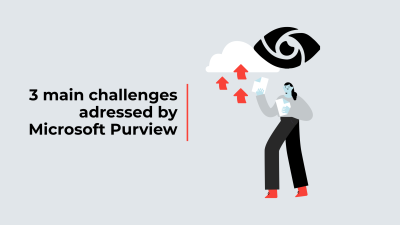WHY USE MICROSOFT AZURE CLOUD SERVICES TO MANAGE YOUR DATA?
The growth of data valorization is showing no signs of slowing down. It has an impact on every part of a business for companies both large and small. Data is just as important for a local corner store as it is for a multinational retailer. Companies are always on the hunt for data and looking to position their data environments properly.
So, how can businesses and IT professionals modernize their analytical solutions? How can they build a new unified architecture, especially if they want to leverage the cloud? The Microsoft Azure cloud services ecosystem provides organizations with a secure data environment that offers the flexibility required for innovation, as well as all the components and capabilities of a modern, flexible solution.
 The importance of data:
The importance of data:
In an analytical context, we need data to understand the past, to acquire new insights, and to produce predictive and prescriptive analyses. It’s not enough to simply collect data if you are not leveraging it and innovating with it as well. To make the most of your data, you need a modern, unified analytical platform that enables both diagnostic and advanced analytics. A solid data management platform is therefore a must for modern-day businesses. A company that manages, governs, and secures its highly valuable data is far more likely to thrive in the new economy.
Why use a cloud service?
Cloud services have become popular thanks to their on-demand storage, processing capacity, flexibility, and security. They help simplify administration and facilitate megadata management, while meeting businesses’ data analysis needs. From a financial standpoint, analytical solutions that use cloud services eliminate the need to spend money on costly hardware and infrastructure.
Additionally, deploying an analytical solution in the cloud is faster, easier, and offers more flexibility than a locally hosted solution. By 2025, the global datasphere will hit 175 zettabytes of data, which is 4 times more than 2020. Many organizations are struggling to leverage this large volume of data. Some are even unaware of the incredible amount of data at their fingertips.
Companies of all kinds have a greater and greater need for data analysis, process automation, and machine learning. Businesses can become even more innovative by using artificial intelligence that triggers processes and decisions.
What’s the best path of adoption?
When kicking off a project in the world of analytics, the best approach is to define an overarching vision while implementing it in an iterative and incremental way. Its implementation should target deliverables that users can leverage, which will be determined based on the company’s values and priorities. Both the system components and your needs will rapidly evolve, so you will need to deliver and implement this solution with agility. This level of flexibility is necessary to ensure the sustainability of the analytical platform within any modern and innovative organization.
Here are three system architecture types that are often used for analytical solutions:
- Departmental architecture is typically implemented to meet a specific department’s needs and to explore data mining capabilities. Due to performance and security constraints, this architecture will eventually need to evolve by onboarding Microsoft Azure cloud services.
- Standard architecture: this is the standard analytics framework, where multiple data sources are integrated and historized. Various Azure cloud services are used to move data between different layers of the solution, with the goal of consolidating, cleaning, standardizing, and storing this data. This architecture is capable of handling much larger volumes of data. The security features are also much stronger. The semantic layer facilitates data modeling that allows the user to consume more data.
- Azure Synapse architecture: organizations can meet all of their analytical needs with a unified cloud platform. This platform enables data integration, exploration, and storage in a single, fully flexible service. When it comes to cost and performance, Azure Synapse is the gold standard. This architecture’s key advantage is its ability to efficiently manage near-infinite volumes of data. With Azure Synapse, you are completely protected: its security features are extremely robust.
In conclusion, to ensure the sustainability of an analytical solution, it is important to focus on a cloud service’s flexibility as a lever for meeting innovative organizations’ needs. The value of your data should never be limited by the underlying technology. If you are considering upgrading your analytics platform, don’t hesitate to ask for help – it is sure to save you time and money.


